


 |
 |
 |
|||
|
|
|||||
| Inside Passage Wildlife - Humpback Whales | ||||
|
By Ron Ferguson, written March 26, 2011 Cruising the famed Inside Passage is not only about world class fishing and incredible scenery - it's also about the wildlife you'll see. The beauty of cruising at 10 kts in a Fleming is that you'll be able to see a tiny rock move on the shoreline, then find that it's actually a brown (grizzly) bear sauntering down the beach. Or, looking up at treetop level you might spot a tiny dark speck - on a closer look with binoculars you'll see it's a bald eagle, intently watching the water's surface for a hint of lunch swimming just below the surface. In this installment of the Inside Passage Wildlife series, we'll look at an amazing adventure we had during one Inside Passage cruise to SE Alaska - to witness humpback whale bubble net feeding, up close and personal. What an amazing sight! Humpback Whale - Migration The SE Alaska-Hawaii migration of humpback whales is surely one of the greatest wonders of the animal kingdom. This annual trek in Pacific Ocean waters is around 6,500 miles roundtrip, and while this isn’t the longest migration in other parts of the world for humpbacks, it must be in more remote waters than anywhere else. Like many human “snowbirds”, these gentle giants winter where it’s warm – in the sub-tropical waters of Hawaii – and summer where it’s cooler – the sub-arctic waters of SE Alaska. According to research on this migration, there are upwards of 6,000 humpbacks in the North Pacific group that summer in SE Alaska (out of an estimated 80,000 worldwide). Some of these migrate southward to the coast of Baja in Mexico; another group heads west across the Pacific to a group of islands south of Japan. But over 60% of them head for the Hawaiian Islands – the most remote island chain in the world. The migration from SE Alaska to Hawaii – a distance of about 3,200 miles – takes around 40 days. They swim at 3-4 miles an hour, and with the ability to switch half of their brain to sleep mode at any time, they can swim 24 hours a day. They begin to depart SE Alaska in early fall, and the first ones to arrive in Hawaii are the mother whales nursing their new-born calves. The second arrival group is the juveniles and newly weaned yearlings. The third group is the adult males – by far the largest group – followed by the pregnant females, who have remained feeding in SE Alaska up to the very last minute. The stay in Hawaii can be as long as six months, giving everyone a chance for lots of R&R. There’s precious little food for a humpback whale in these waters, and by late May or early June they’re hungry enough for the trip back to the food-rich colder waters for a good meal and to replenish their blubber. The humpback whale is the fifth largest whale in the world, weighing in at over 75,000 lbs (about the weight of a Fleming 55 loaded with full fuel). They range in length from 39-52’ for males, and 52-56’ for females. (Yes, this is one of the few mammalian species where the typical female is larger than the male.) Their huge mouths hold up to 400 baleen plates, through which they filter their food – eating up to 2,000 lbs in a day’s time. The neck has huge ventral grooves to expel the water after a load of krill, herring, and salmon have rushed through the mouth. Atop their huge snout are a pair of blowholes – actually, they’re nostrils – and since whales cannot breathe through their mouth, they inhale and exhale only through the blowholes. 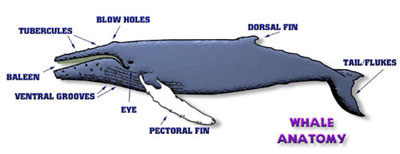 The humpback whale is truly a leviathan, equal to the length and weight of a typical Fleming 55. (Click on any image to enlarge.)
The humpback whale is truly a leviathan, equal to the length and weight of a typical Fleming 55. (Click on any image to enlarge.)Whale Watching But enough of this background stuff – let’s talk about getting up close to these goliaths. Luckily for us North American West Coast dwellers, we can whale watch at either end of the migration – sitting on a sunny lanai of our Maui beachfront hotel, or cruising along the Inside Passage in our Fleming. A day without seeing at least one “blow” across the water is somewhat rare during the season these massive mammals are in residence.  SE Alaska is a tiny (in relative terms) strip of coastal land that runs southward along the top half of Canada's British Columbia province. At the southern tip lies Ketchikan, gateway to SE Alaska and 680 miles (as the crow flies) from Seattle. From there it's a further 185 miles to Sitka, located on the west side of Baranof Island and facing the Gulf of Alaska. Anchorage (seen at the very top left of the image) is at the southern edge of the Alaska mainland, and from there the state extends another 725 miles to Barrow - on the North Slope and one of the northernmost cities in the world. Alaska is immense - over twice the size of Texas!
SE Alaska is a tiny (in relative terms) strip of coastal land that runs southward along the top half of Canada's British Columbia province. At the southern tip lies Ketchikan, gateway to SE Alaska and 680 miles (as the crow flies) from Seattle. From there it's a further 185 miles to Sitka, located on the west side of Baranof Island and facing the Gulf of Alaska. Anchorage (seen at the very top left of the image) is at the southern edge of the Alaska mainland, and from there the state extends another 725 miles to Barrow - on the North Slope and one of the northernmost cities in the world. Alaska is immense - over twice the size of Texas!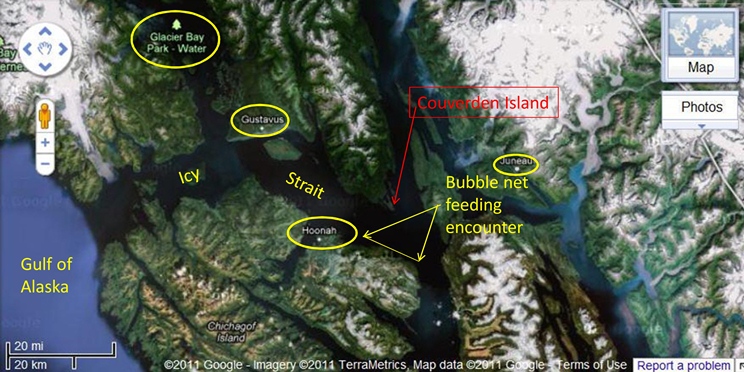 This Google Maps satellite image shows a closer view of the SE Alaska area to the south of Glacier Bay National Park, and where our humpback whale bubble net feeding adventure occurred.
This Google Maps satellite image shows a closer view of the SE Alaska area to the south of Glacier Bay National Park, and where our humpback whale bubble net feeding adventure occurred.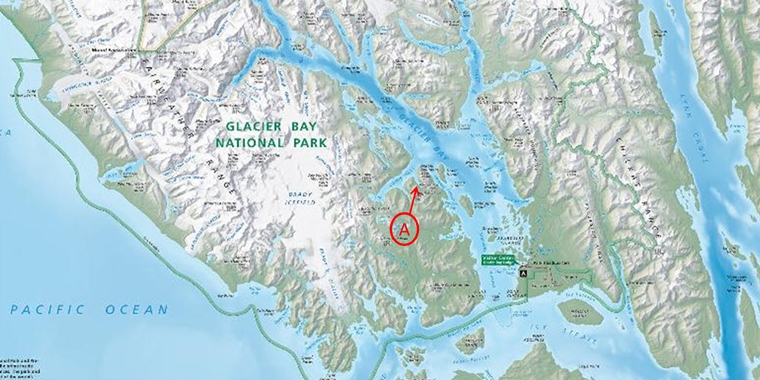 We just ended a wonderful 7-day stay in Glacier Bay National Park, anchoring in a tiny bay (marked with a red A) near the entrance to the park. Early in the morning we headed southward to the park entrance a few miles to the south. We crossed Icy Strait, then turned east to follow Chichagof Island on our way to Sitka.
We just ended a wonderful 7-day stay in Glacier Bay National Park, anchoring in a tiny bay (marked with a red A) near the entrance to the park. Early in the morning we headed southward to the park entrance a few miles to the south. We crossed Icy Strait, then turned east to follow Chichagof Island on our way to Sitka.For the story at hand, what we witnessed on a mid-July morning as we cruised along the aptly-named Icy Strait in SE Alaska totally knocked our socks off. This particular morning, we awoke at anchor in a tiny cove inside Geikie Inlet on the west side of the park. After raising our anchor at first light, we motored slowly through Whidbey Passage and exited the park through Sitakady Narrows. Along the way, we saw several humpback whales swimming on the surface, and twice we stopped dead in the water when we were within 100 yards, allowing them to pass. It was always interesting to see them on the surface, and they were easy to spot, spraying a fine mist at least 10’ in the air from their blowholes the moment they were on the surface. Seeing a partial or full breech is pretty rare, though, and the most you’ll usually see is a bit of their back out of the water, the dorsal fin sticking up, and maybe the tail fluke arching through the air as they descend. 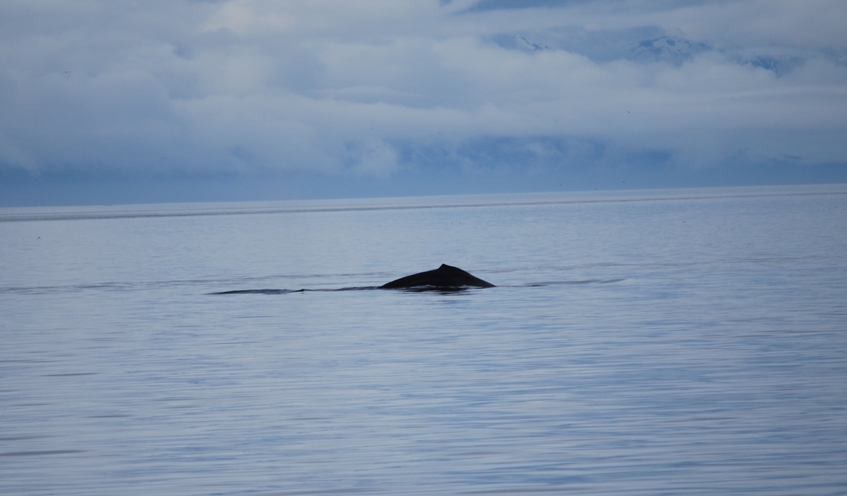 These are the two most frequent images of a humpback whale you’ll see – porpoising along with the dorsal fin rising out of the water as it arches its back on the surface.
These are the two most frequent images of a humpback whale you’ll see – porpoising along with the dorsal fin rising out of the water as it arches its back on the surface. Then you might see a bit of the tail fluke rising out of the water before the whale disappears beneath the surface again.
Then you might see a bit of the tail fluke rising out of the water before the whale disappears beneath the surface again.The speed limit within the park is a very strict 6 kts to ensure that whales aren’t hit (we later heard from a friend who left the park around the same time as us that he received a speeding ticket from a park police patrol boat – he swears they mistook him for another boat nearby, but they didn’t buy it.) At one point a whale watching boat radioed the location of several whales on the surface that we hadn’t seen. We kept our speed down until we were well clear. 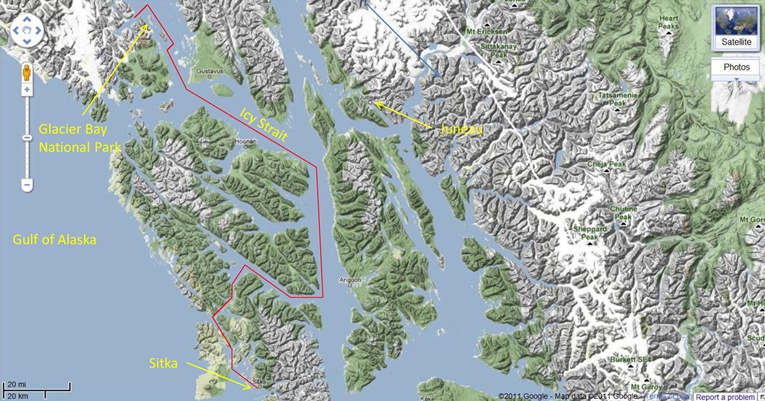 With this Google Map terrain view of our route you can see our 3-day route from Glacier Bay National Park to Sitka.
With this Google Map terrain view of our route you can see our 3-day route from Glacier Bay National Park to Sitka.By mid-morning, we were out of Glacier Bay National Park, and crossing Icy Strait towards Point Adolphus on the northernmost point of Chicagof Island. It was July 15th, and we were bound for Sitka to drop off some friends from Seattle who had flown in for a week’s cruise with us in the park. Our route was SE on Icy Strait, down the east side of Chichagof Island, then south on Chatham Strait. Abreast of Angoon, we’d turn west into Peril Strait to make our way across to the west side of the island to reach Sitka.  This Google Map satellite view provides a closer look at Icy Strait as it follows along the top end of Chichagof Island. Our humpback whale bubble net feeding adventure extended for at least a 10 mile stretch along this coastline.
This Google Map satellite view provides a closer look at Icy Strait as it follows along the top end of Chichagof Island. Our humpback whale bubble net feeding adventure extended for at least a 10 mile stretch along this coastline.Icy Strait is the most northern section of the Inside Passage, and separates Chichagof Island to the south and the Alaska mainland to the north. It’s typically 3 miles across, and runs 40 miles east to west, meeting up with Lynn Canal and Chatham Strait at the east end. Westward, it meets up with the Gulf of Alaska at Cross Sound. As its name implies, the waters of Icy Strait are ice cold, and nurture abundant salmon and halibut stocks – as well as being a favorite feeding ground for humpback whales. 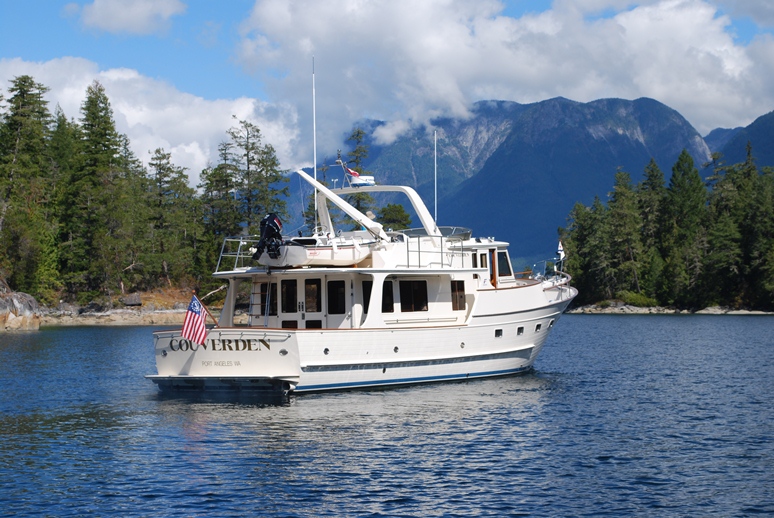 As a sidelight to this story, along the north shore of Icy Strait, where it meets Lynn Canal, is Couverden Island, named by George Vancouver during his exploration of the Pacific Northwest in 1792-1794 – in honor of the “seat of my [Dutch] ancestors”. Fleming 55-087 is named Couverden, as this area was one of their favorite places to explore on frequent cruises to SE Alaska.)
As a sidelight to this story, along the north shore of Icy Strait, where it meets Lynn Canal, is Couverden Island, named by George Vancouver during his exploration of the Pacific Northwest in 1792-1794 – in honor of the “seat of my [Dutch] ancestors”. Fleming 55-087 is named Couverden, as this area was one of their favorite places to explore on frequent cruises to SE Alaska.)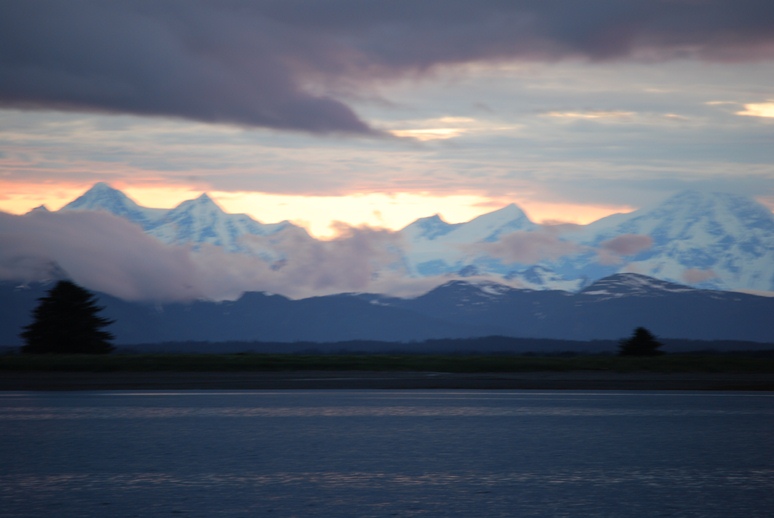 This sunset photo, taken from our anchorage in the calm Icy Passage just outside Glacier Bay National Park near Gustavus. This entire area is drop-dead beautiful, with absolutely stunning mountain backdrops in every direction you look. It’s no wonder this is cruise ship heaven, but we’re really glad to be on our own private “cruise ship”.
This sunset photo, taken from our anchorage in the calm Icy Passage just outside Glacier Bay National Park near Gustavus. This entire area is drop-dead beautiful, with absolutely stunning mountain backdrops in every direction you look. It’s no wonder this is cruise ship heaven, but we’re really glad to be on our own private “cruise ship”.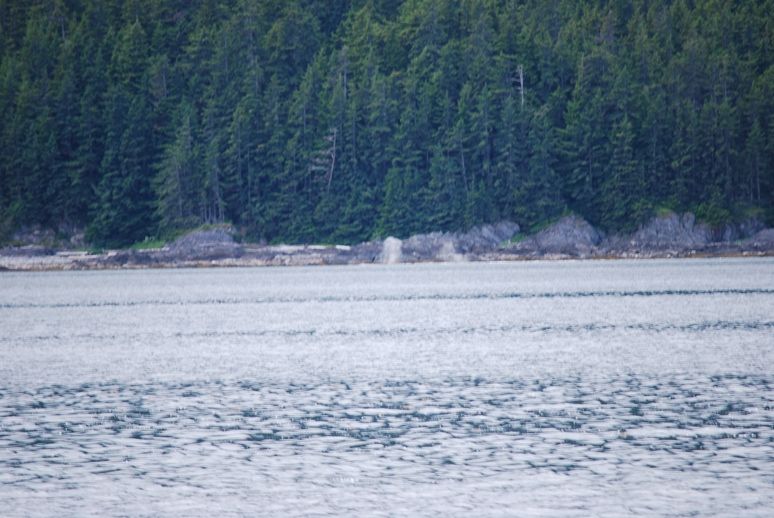 At first, all we spotted was a single telltale cloud of blowhole mist along the shoreline – the unmistakeable sign of a humpback whale surfacing.
At first, all we spotted was a single telltale cloud of blowhole mist along the shoreline – the unmistakeable sign of a humpback whale surfacing.As we motored along Icy Strait at about 10 kts, Kap noticed several humpback whale blows right along the water’s edge, very near to the shoreline of Chichagof Island. She also spotted two small boats very close to the location of the blows. As we watched, we could very clearly see the humpbacks moving along the rugged shoreline, with the boats following them at what seemed to be within the required 100 yard safety limit. Kap slowed down and steered us closer to the shore to get a better idea of what was going on. As we approached, staying about ¼ mile offshore, she matched the speed of the whales, as well as the two boats shadowing them. Through binoculars we could see an Alaska commercial fishing license number on one boat’s hull. I positioned myself on the bow to take photographs in the event it looked like they were harassing the whales. 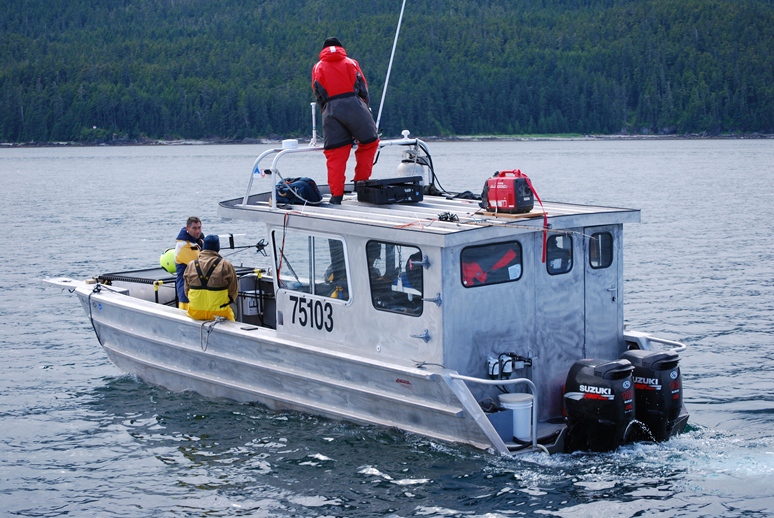 The larger of the two boats that we saw near the whale pod came out to us. The number just below the pilot house side window is an Alaska commercial fishing vessel registration number. Note the yellow camera helicopter just barely visible behind the guy on the bow.
The larger of the two boats that we saw near the whale pod came out to us. The number just below the pilot house side window is an Alaska commercial fishing vessel registration number. Note the yellow camera helicopter just barely visible behind the guy on the bow.Suddenly, the larger of the two boats veered towards us, and it was obvious it was coming out to us. My immediate reaction was, “this could be difficult . . . they’re going to try to scare us off”. Instead, when the boat was within 20’ of us, the skipper slid open his pilot house window and hollered over in a friendly manner, “where are you guys from?” We answered back, “. . . the Seattle area.” He responded, “So are we – we’re working on a whale migration film and we’ve been following this pod of humpbacks for several days now. How about if you follow behind us and get some good close-up photographs. Stay well behind us, as we’ll be within the legal limit of how close you can be to the whales – we have a permit for that, but since you don’t, you don’t want to get caught too close to the pod.” On the bow sat a very interesting looking remote-controlled helicopter, and instead of the pilot/passenger cabin was a yellow pod containing a camera. 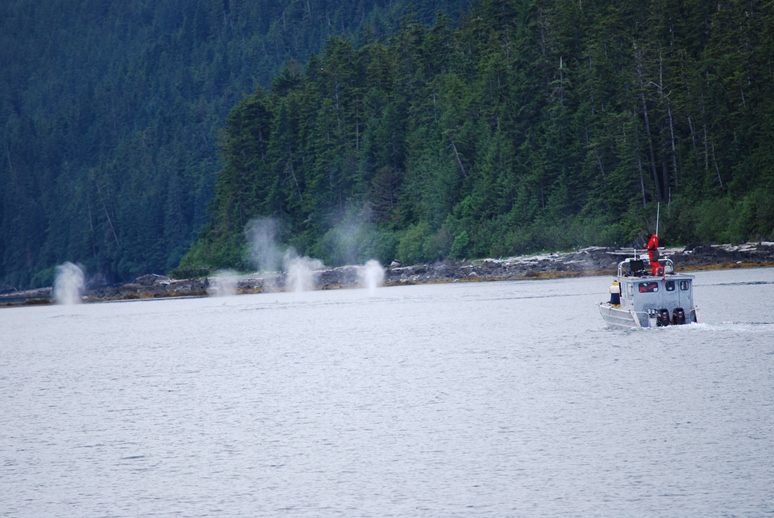 As we followed the boat towards the shoreline, it became obvious what was going on – the rapid sequence of bubbles rising to the surface and forming plumes of mist could only be a bubble feeding event.
As we followed the boat towards the shoreline, it became obvious what was going on – the rapid sequence of bubbles rising to the surface and forming plumes of mist could only be a bubble feeding event.At that, he motored towards the shore and we followed a few hundred yards behind. As we neared the shore, we could now see the other boat more clearly. It was a rubber pontoon boat, maybe 30’ in length, and rigged to be a floating camera platform, with the primary camera mounted on a boom that extended over the top of the nine people aboard. A guy who seemed to be the filming director sat at the bow with his back to the rest of the crew.  The main camera boat was a 30’ pontoon craft, loaded to the gunnels with nine people, and with a camera boom mounted at the stern.
The main camera boat was a 30’ pontoon craft, loaded to the gunnels with nine people, and with a camera boom mounted at the stern.As we watched, it finally dawned on us what was going on – the humpback whale pod was bubble net feeding – and we had a ringside seat!  The camera boat got in very close to the pod during the underwater net building by the whale pod. We stayed a safe distance behind, and definitely outside the 100 yard limit.
The camera boat got in very close to the pod during the underwater net building by the whale pod. We stayed a safe distance behind, and definitely outside the 100 yard limit.The whale pod moved from one small shoreline indentation to another, apparently using the contours of the shore itself to help them corral the fish. We watched mesmerized as the pod circled below the surface, blowing continuous streams of bubbles rising to the surface that confused the fish within the circle. As the whales tightened the circle of bubbles, they would then swim straight up through the inside, with their huge mouths wide open, gulping in hundreds, possibly thousands of fish as they headed for the surface. They’d all rise out of the water at the same time, mouths still agape, and you could clearly see the ventral grooves spread open to expel the huge amount of water they were taking in as they rose. They’d crash sideways to the water’s surface, and the water seemed to be roiling with these huge beasts thrashing around. Within moments, the water’s surface was calm again and we’d them motor along behind the camera boats to the next shoreline indentation. There the scene would repeat – and it went for at least five iterations.  The waters are calm, but with the remote control helicopter hovering overhead we know something’s about to happen.
The waters are calm, but with the remote control helicopter hovering overhead we know something’s about to happen.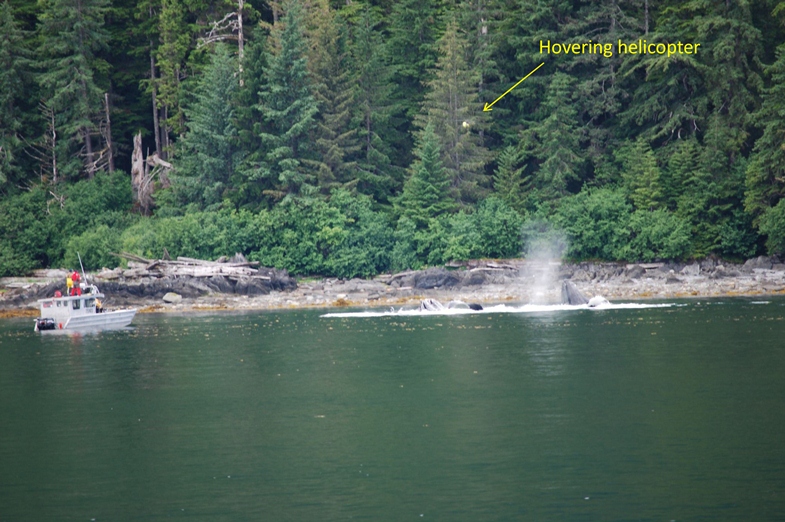 Moments later, a group of whales bursts through the surface. Amazingly, the helicopter is positioned perfectly overhead to catch the action close up. They had to have an underwater microphone to know exactly where and when it would happen.
Moments later, a group of whales bursts through the surface. Amazingly, the helicopter is positioned perfectly overhead to catch the action close up. They had to have an underwater microphone to know exactly where and when it would happen.We noticed that just before the whales rose to the surface each time, the helicopter was launched and hovered directly over the spot where the whales came up. Obviously, the camera crew knew what was going on, and we concluded they must have an underwater microphone and were picking up sounds that gave an indication of when the surface rush would begin. Humpback whales are known for their very distinctive “songs” associated with mating habits, but we surmised they must also use this in some way to choreograph their bubble net feeding as well. 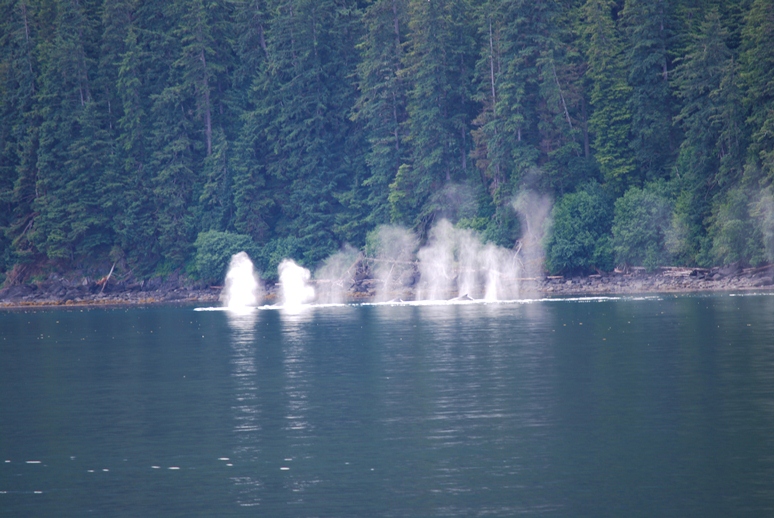 At times there were at least 8-10 “blows” rising up from the surface as the bubble net was formed. At the same time, there were always several whales swimming on the surface. We never really knew how many whales were in this pod, but it had to be at least ten.
At times there were at least 8-10 “blows” rising up from the surface as the bubble net was formed. At the same time, there were always several whales swimming on the surface. We never really knew how many whales were in this pod, but it had to be at least ten. Here’s the most amazing photo. The whale in the center was perfectly positioned to us, giving us a fantastic shot of his/her underside during the rise straight up out of the water. Others, like the two at left had already started to crash over on their side as they came out of the water.
Here’s the most amazing photo. The whale in the center was perfectly positioned to us, giving us a fantastic shot of his/her underside during the rise straight up out of the water. Others, like the two at left had already started to crash over on their side as they came out of the water. Here’s the best I can do zooming in on the photo. Note the huge ventral grooves that are wide open. The dark area in the center of the grooves is not the mouth – rather, the mouth is at the very top end of the snout (as you can see from the two whales on the left).
Here’s the best I can do zooming in on the photo. Note the huge ventral grooves that are wide open. The dark area in the center of the grooves is not the mouth – rather, the mouth is at the very top end of the snout (as you can see from the two whales on the left).When a half hour was up (and I’d taken almost 200 photographs), the main camera boat turned towards us, and when they were alongside they asked if we’d gotten our fill of photographs. Without specifically saying, it was obvious they wanted us to go away – we figured the sounds of our engines and props were probably interfering with their underwater microphone, or possible having some effects on the natural behavior of the whales. We thanked them for giving us a most wonderful show of humpback whale bubble net feeding – up close and personal – and we motored off on our day’s cruise. What an amazing experience! Unfortunately, we never learned anything more about the film they were making – who they were, who they were making the film for, and when/where it would be shown. We’ve watched for it on our local PBS station, on the Discovery Channel and on the National Geographic Channel, but haven’t run across it so far. |
||||
| Copyright © 2010 MDT Consulting. All rights reserved. | Visit the Fleming manufacturer's web site | Use & Privacy Policy | Contact us |